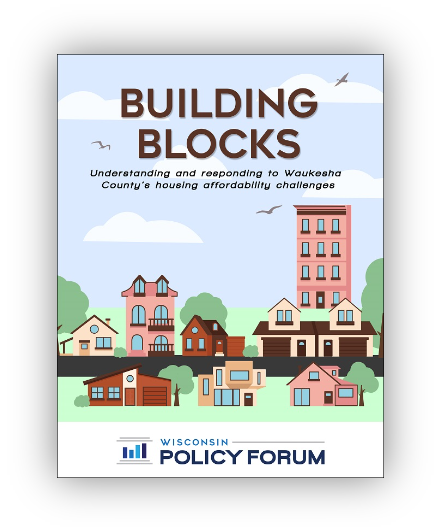Building Blocks: Addressing Waukesha County’s Housing Affordability Challenges
Click here to read the full report
Report Published July 2023
Introduction
Waukesha County’s affordable housing challenges have reached new heights due to economic trends stemming from the COVID-19 pandemic, demanding consideration of strategies to reduce the cost of renting, buying, and building homes, a new Wisconsin Policy Forum report finds.
Factors contributing to the problem include housing costs that are increasing far more rapidly than incomes, the lackluster recent pace of production of rental and owner-occupied housing, and regulatory and other barriers to new development.
The report analyzes a wide array of housing-related data and municipal policies. It includes reflections from stakeholder interviews with local government officials, developers, and employers, and explores how local and state governments are addressing similar challenges nationally.
Key Challenges & Development Barriers to Affordable Housing
High housing costs are already out of reach for many and rising faster than incomes.
The median value of homes in Waukesha County was the highest of any Wisconsin county in 2021, while the county’s median rent was only exceeded in Dane County. These difficulties have intensified, as the county’s median home sales price increased by over 41% between 2016 and 2021, while its median household income rose only 15%.
Inventory is low and housing production is not keeping up with demand.
The number of homes listed for sale in Waukesha County has declined, while the vacancy rate in the owner-occupied market was just 0.2% in 2021. The county added nearly 1,200 more households than housing units between 2010 and 2021, as fewer units were permitted than in the years preceding the Great Recession.
Very little affordable rental housing has been built in the last decade.
Between 2013 and 2023, only three developments in the county totaling 176 affordable units were supported with federal or state low-income housing tax credits, which typically are needed to finance affordable rental housing developments.
Zoning regulations limit the variety of housing that can be produced and impact housing costs.
Some Waukesha County municipalities restrict developers from building smaller homes on smaller lots, which can add to the total cost of homes. In the last five years, the average size of new lots created by subdivision was twice as large in Waukesha County (0.67 acres) as in Dane County (0.31 acres).
Many Waukesha County municipalities also prohibit duplexes and multi-family housing development in most areas of their communities, bar the construction of accessory dwelling units, or impose extensive parking requirements on multi-family housing that add to the cost of each unit.
The cost of infrastructure and utility extensions and expansions are additional barriers.
When subdivisions are created, water and sewer services, private utilities, roads, and sidewalks must be built or extended. For multi-family housing, more intensive modifications often are needed. Local government leaders and area developers we interviewed said these costs can be prohibitive.
Public opposition poses a major obstacle to affordable and workforce housing development.
Developers commonly propose denser, mixed-income housing, but community members frequently oppose such developments due to concerns about potential impacts on traffic, parking, or property values. This can cause delays, increase costs, or derail projects entirely.
Many other factors that local communities cannot or do not wish to change contribute to high housing prices and construction costs.
These include inflated building material prices, delays stemming from supply chain issues, rising interest rates, and limited innovation in housing construction. Others are assets communities wish to preserve, such as school district quality, which makes many Waukesha County communities attractive for families with children but also may raise housing costs due to strong market competition.
Both state and local action could play a role in fostering housing affordability in Waukesha County. In June, Gov. Tony Evers signed a bipartisan package of housing bills into law, which could address issues raised in this report. Potential strategies identified in our research and supported by key stakeholders include:
Potential Solutions for Affordable Housing
Zoning changes, such as allowing for smaller homes on smaller lots; permitting duplexes in districts zoned for single-family housing; allowing multi-family housing development in more places, including commercial districts; permitting accessory dwelling units; and reducing or eliminating minaimum parking requirements for multi-family housing developments.
Expediting development approval processes, as time spent waiting for municipal permitting and approval adds considerably to total project costs. Local governments or the state could set limits on the time municipalities can take for those approvals.
Better funding strategies. Multi-family affordable and workforce housing development typically requires some public funding to be viable. For both multi-family and single-family housing, infrastructure often poses a challenge, including the need to build or modify sewer and water connections. Municipalities could consider using TIF or other funding sources or could create or bolster affordable housing funds.
New or expanded use of alternative building methods, such as increasing the use of prefabricated housing or expanding the development of attached single-family townhouses.
Additional public education to raise awareness about the problem. Given the frequency of community opposition to proposed housing developments in general – and affordable housing specifically – stakeholders we interviewed said more public education is needed about the county’s rising housing costs, and how this issue is impacting area employers and the county’s overall economic health.
Report Author:
Joe Peterangelo, Senior Researcher
Research and Editing Assistance:
Rob Henken, President
Jason Stein, Vice President and Research Director
Sebel Fusi, Research Intern
This report was commissioned by the United Way of Greater Milwaukee and Waukesha County, the Waukesha County Business Alliance, the Waukesha County Center for Growth, and the Waukesha County Community Foundation.





